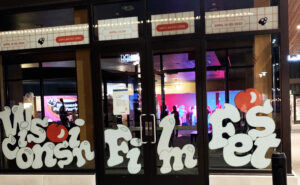The journey to organize the Wisconsin Film Festival, which attracts nearly 30,000 people each year, begins now, a full seven months in advance, with organizers who slog through hundreds of films to find the lucky 150 that will be screened.
In April 1999, the festival made its debut, attracting movie enthusiasts from across the country to Madison. Since its inaugural event, the festival, still held every year in April, has witnessed substantial growth, solidifying its position as one of the United States’ largest campus-based film festivals, according to organizers. The festival’s primary aim remains unchanged: to unite film enthusiasts, aspiring filmmakers and eager audiences for an eight-day celebration of cinema.
In April 2022, ticket sales reached 28,000, marking a 3,000-ticket escalate from the previous year, according to Benjamin Reiser, the festival’s director of operations. While peak ticket sales were seen during 2010-2012, post-pandemic attendance continues to rise, bolstered by the festival’s reputation for captivating newcomers, said Jim Healy, the director of the festival’s programming since 2011.
Healy, along with Michael King, the festival’s artistic director, dedicates countless hours to watching an extensive array of films from renowned film festivals, such as the Chicago Film Festival, Toronto International Film Festival and Sundance Film Festival. But the Wisconsin Film Festival also premieres films that have yet to be aired at any other festivals. It’s King and Healy’s keen judgment and discerning taste that shapes the festival’s lineup.
“I know when I’m absorbed by something,” Healy said. “It’s a matter of being engaged…the best art is also the best entertainment.”
Both Healy and King view hundreds of films yearly.
Once they’ve selected films for the festival, the next step involves negotiating agreements with distributors to secure the rights for screenings, which often presents challenges.
“Just because we’re able to see a movie at another festival or through a screener from a distributor, doesn’t necessarily mean that the movie is going to be available for us for the festival,” Healy said.
Oftentimes, films have certain distribution regulations that prevent them from being included in the festivals.
“In some cases, you will be reaching out directly to the filmmaker,” Healy said.
However, more frequently, Healy and King engage in negotiations with American distribution companies. These companies serve as direct sources, providing them with films they’ve encountered at festivals or screenings, Healy explained.

The end result of the programmers’ difficult work is a diverse showcase of over 150 films encompassing a wide range of genres, from narratives, animations and experimental works to documentaries, shorts and restored classics. However, Healy and King’s roles extend well beyond just selecting films for the festival.. They aim to curate collections of films within each festival that resonate with each other, forging connections through common themes and concepts.
“The greatness of movies is the interactive dialogue [they’ve] always had,” said Healy.
In practice, the festival’s filming schedule is thoughtfully adjusted to group films that share common themes or are interconnected, allowing viewers to engage in insightful and impactful comparisons.
“Sometimes something will click right away because it’ll relate to another film we’ve already selected for screening, thematically or via the same artists involved,” said Healy. “Or they offer a contrarian take or a different mode of storytelling in relation to something else we’re showing at the festival that might have a similar subject.”
For instance, in April 2023, the festival showcased the recently released documentary “Judy Blume Forever,” and alongside this nostalgic story delving into Blume’s well-loved coming-of-age novels, it featured the 1952 rendition of “Jack and the Beanstalk,” creating an captivating conversation between the two films from different eras that both were about children’s literature.
In his role, Reiser stresses the importance of careful attention to detail as he oversees the management of venues, festival dates, sponsorships and logistical aspects. And each year presents up-to-date challenges.
“Every year it’s like starting from scratch,” said Reiser. “Our festival shows films from all around the world and throughout the entire history of movies.”
One of the defining features of the Wisconsin Film Festival is its remarkable inclusion of films spanning from 50 to over 100 years ancient, adding to its unique appeal.
“Our audiences have a voracious appetite for all kinds of cinema from throughout cinema history,” said Healy.
Alongside films that date back to the origins of cinema, there is a section of the festival solely dedicated to films with a tie to Wisconsin, explained Reiser, who also directs the “Wisconsin’s Own” programming.
“For a lot of these films, especially for the ‘Wisconsin’s Own’ films, this might be the only time they ever get shown in a movie theater,” Reiser said.
Around 30 films are chosen from the 150 submissions to the ‘Wisconsin’s Own’ section, according to Reiser. Often, the filmmakers themselves attend the festival, engaging in Q&A sessions and celebrating their work with the audience. It’s a infrequent opportunity for attendees to connect with the creators behind the art.
“It’s these magical screenings where the filmmakers are there,” said Reiser.
Reiser takes immense pride in their careful programming process, striving for improvement each year. He acknowledged the decline of established movie-going culture and the reluctance of younger generations to embrace theaters. While Reiser can’t change the current state of theaters, he ensures that the Wisconsin Film Festival does things right, having projectionists at every theater and testing each film before it’s presented to an audience.
Beyond the logistical aspects, what truly sets the festival apart is the sense of community it fosters among its attendees. In a time when established cinema culture is waning, the festival continues to attract a growing audience each year.
“This is a festival that has succeeded at being exciting and attractive to new viewers,” said Healy. “We’re able to fill up theaters year after year because of our reputation…I’m really proud of that.”
The community created among viewers is an element of the Wisconsin Film Festival that keeps people coming back.
“We’re all about this sense of community,” said Reiser. “It’s the communal experience of going to a movie with a bunch of people, some of whom you may know but most of whom you don’t.”



